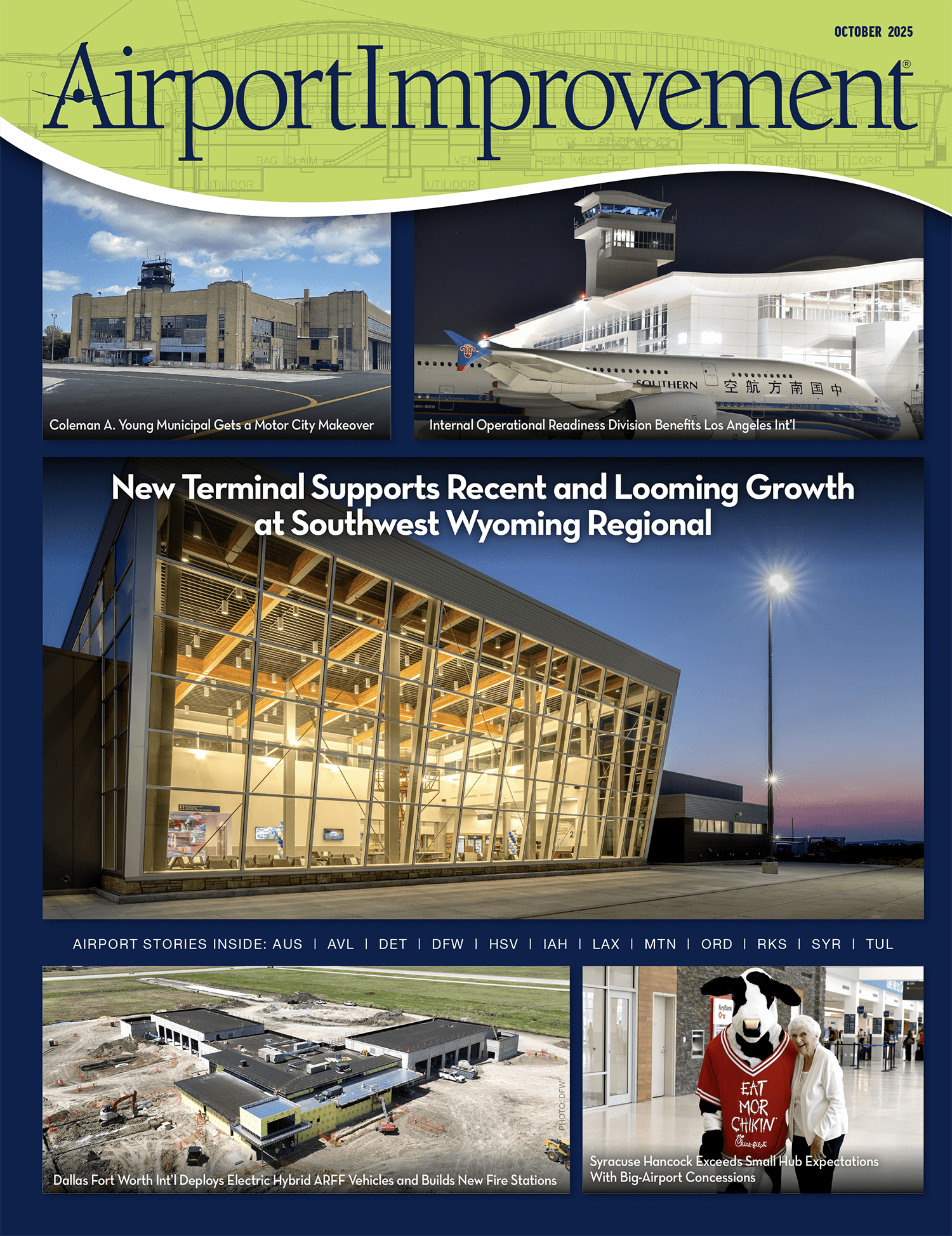
Surrounded by the Cascade and Siskiyou mountain ranges, Rogue Valley International-Medford Airport (MFR) in southwest Oregon has always been prone to freezing fog and the operational complications associated with it. These days, however, MFR is using a new system developed by its own staff to diffuse fog and help reduce flight delays and cancellations. That’s good news for passengers on about 56 flights per day, many who are connecting to eight larger hub airports.
With positive results in all 12 deployments since the system’s December 2011 debut, MFR officials consider the new system a success – and an important safety enhancement.
|
factsfigures Project: Fog Diffusion System Location: Rogue Valley Int’l-Medford (OR) Airport Developer/Fabricator: Airport Staff Cost of Materials: $10,000 Strategy: Disperse dry ice from helium balloon tethered to airport truck System Specs: 18-foot, 75-pound helium balloon; 700-foot, 1/4-inch cables rated at 3,000 lbs.; remotely-controlled, battery-operated dispenser Balloon Supplier: Aerial Products Helium Supplier: Air Gas Balloon Retrieval Time: 90 seconds Key Benefits: Eliminates safety risks of aircraft flying in foggy, icy conditions to disperse dry ice Track Record: Successful in 12 of 12 initial deployments |
“After conducting the seeding, the aircraft would then be required to fly out 25 miles to align  with the ILS [instrument landing system],” explains airport director Bern Case. “In some cases, the hole that opened would be closed by the time it took a small aircraft to fly this pattern.”
with the ILS [instrument landing system],” explains airport director Bern Case. “In some cases, the hole that opened would be closed by the time it took a small aircraft to fly this pattern.”
Deputy director of operations Robert Russell remembers one foggy evening when visibility was so poor, the fog seeding aircraft couldn’t land at MFR and had to divert to another airport in northern California. “It was a dangerous situation, because the pilot had to fly over the mountains and ice began to form on the wings,” Russell recalls.
Seeds of Change
After MFR terminated its previous “aircraft weather modification program,” staff members brainstormed to devise an alternative method. Building on other airports’ practice of distributing liquid carbon dioxide (dry ice) from the ground during cold conditions, the staff developed a system that used a helium balloon to distribute the same fog-busting material from a higher elevation.
The airport’s new system, which includes a power winch to launch and retrieve the tethered balloon and a remotely controlled dry ice dispenser, was fabricated onsite at MFR over an 18-month period. Materials for the system cost about $10,000, with the 18-foot, 75-pound Kingfisher helium balloon accounting for fully $7,500 of the expenses.
Airport staff based the system on the same principles as a fertilizer spreader. Its spreading device, however, is powered by a 12-volt battery and distributes dry ice from a helium balloon tethered to a moving vehicle. Airport operations personnel launch the balloon to 500 feet using a power winch permanently attached to the back of a truck. Once the balloon is at altitude, crews on the ground activate the dispersal system and the truck travels about 3/8 of a mile along the nearly two-mile runway.
The airport calls its new system CASPER – short for cable-attached system providing effective release.
Refining CASPER
MFR’s balloon-based method faced several challenges between fall 2010, when it was field tested, and December 2011, when it was put into active use. 
The largest hurdle to clear, notes Case, was meeting FAA Safety Management System standards and regulations. Receiving its Certificate of Waiver last summer was a major milestone for the budding operation.
 “The FAA had several safety concerns relating to both their standards and those of the International Civil Air Operations,” Case recalls.
“The FAA had several safety concerns relating to both their standards and those of the International Civil Air Operations,” Case recalls.
One was balloon retrieval speed. Initially, it took crews about 41/2 minutes to winch the flying balloon back to the vehicle, he explains. When the FAA asked the airport to expedite the process, staff reduced the retrieval time to just 90 seconds by using a larger spool.
The prospect of the balloon getting loose was another major concern of the FAA, so staff added a second cable for extra safety. Each of the 700-foot, quarter-inch thick cables is rated at 3,000 pounds and, like the balloon, is inspected after each operation. If the balloon would manage to break loose, MFR is required to notify the FAA and National Aeronautics and Space Administration promptly.
The operation also faced the logistic challenge of a potential helium shortage during the program’s development. Fortunately, officials convinced their supplier that it was imperative for the airport to maintain an ample inventory of the gas.
 Launch Day
Launch Day
After more than a year of fabrication, preparation, test runs and safety checks, CASPER was successfully deployed to disperse fog at MFR for the first time on December 1, 2011.
“The temperature in the inversion layer has to be freezing or below for the dry ice to work effectively,” Case explains. “We were all extremely pleased to see how successful CASPER truly was.”
After seeding, visibility is raised from as low as 600 to 800 feet to about 2,400 feet – sometimes in less than 20 minutes, he reports.
“We have been very successful,” agrees Russell. “In the 12 times we have already used CASPER, we have been successful 12 out of 12 of those times.”
News of MFR’s success diffusing flight-disruptive fog is apparently spreading fast. By January, several airports had contacted Case regarding CASPER and its production.



